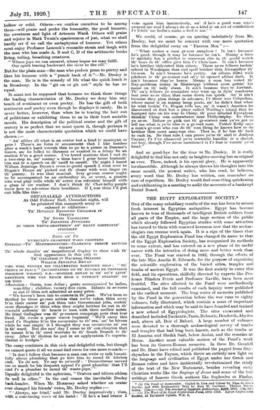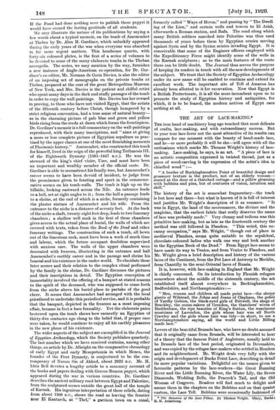THE EGYPT EXPLORATION SOCIETY.*
ONE of the many subsidiary results of the war. has been to arouse fresh interest in Egyptian. antiquities. Egypt has become known to tens of thousands of intelligent British soldiers from all parts of the Empire, and the large section of the public which already followed Egyptian studies with some attention has turned to them with renewed keenness now that the archae- ologists can resume work again. It is "a sign of the times that the old Egypt Exploration Fund has changed its name to that of the Egypt Exploration Society, has reorganized its methods to some extent, and has entered on a new phase of its useful career with the intention of doing more and better work than ever. The Fund was started in 1882, through the efforts of the late Miss Amelia B. Edwards, for the purpose of organizing the scientific exploration of the buried cities, temples and tombs of ancient Egypt. It was the first society to enter this field, and its operations, skilfully directed by experts like Pro- fessor Flinders Petrie and Professor Naville, have been most fruitfuL The sites allotted to the Fund were methodically examined, and the full results of each inquiry were published at the earliest moment. The long series of memoirs published by the Fund in the generation before the war runs to eighty volumes, fully illustrated, which contain a mass of important information and which may be said to have founded and trained a new school of Egyptologists. The sites excavated and described included Naukratis, Tanis, Bubastis, Dendereh, Abydos and, above all, Deir el Bahari. A large number of volumes were devoted to a thorough archaeological survey of tombs and temples that had long been known, such as the tombs at El. Amarna and Sheikh Said, below. Assiut, and the remains at Meroe. Another most valuable section of the Fund's work has been its Graeco-Roman memoirs. In these Dr. Grenfell and Dr. Hunt have edited and published the papyri from Oxy- rhynchus in the Fayum, which throw an entirely new light on the language and civilization of Egypt under her. Greek and Roman rulers and have incidentally revolutionized the study of the text of the New Testament, besides revealing early Christian works like the Sayings of Jesus and some of the lost writings of famous Greek authors like Sophocles or Pinder.
• (1) The Tomb of Aniexemhet. Copied in Line and Colour by Nhia de Gans Davies, and with Explanatory Text by Alan H. Gardiner. Theban Tombs Series. (303.] (2) The Journal of Egyptiem Archaeology. Axil. 3220. (12e. ed.) —(3) The Work of the Egypt Exploration F=41882-19114. Egypt Exploration &May. 18 Te,vistocx Square. W.C. 1.
If the Fund had done nothing save to publish these papyri it would have earned the lasting gratitude of all students.
We may illustrate the nature of its publications by saying a few words about a typical memoir, on the tomb of Amenemhet at Thebes by Dr. Alan H. Gardiner, which unluckily appeared during the early years of the war when everyone was absorbed in far more urgent matters. This handsome quarto, with forty-six coloured plates, is the first of a series of volumes to be devoted to some of the many elaborate tombs in the Theban necropolis. The series, we may mention by the way, furnishes a new instance of Anglo-American co-operation, for Dr. Gar- diner's co-editor, Mr. Norman de Garis Davies, is also the editor of an imposing set of monographs on the private tombs at Thebes, prepared at the cost of the great Metropolitan Museum of New York, and Mrs. Davies is the patient and skilful artist who spent many days in the dark and stuffy passages of the tomb in order to copy the wall-paintings. Mrs. Davies has her reward in proving, to those who have not visited Egypt, that the artists of the fifteenth century before Christ, though hampered by a strict religious convention, had a true sense of natural beauty— as in the charming picture of pale blue and green and yellow birds rising from the reeds at dawn which forms the frontispiece. Dr. Gardiner's memoir is a full commentary on the wall-paintings reproduced, with their many inscriptions, and " aims at giving a more or less complete picture of Egyptian sepulture as prac- tised by the upper classes at one of the most flourishing moments of Pharaonic history." Amenemhet, who constructed this tomb for himself, lived in the reign of the powerful king Tuthmosis III. of the Eighteenth Dynasty (1501-1447 B.c.). He was the steward of the king's chief vizier, User, and must have been an important and wealthy member of the official caste. Dr. Gardiner is able to reconstruct his family-tree, but Amenemhet's career seems to have been devoid of incident, to judge from the prominence given to feasting and sport in the commemo- rative scenes on his tomb-walls. The tomb is high up on the hillside, looking eastward across the Nile. An entrance leads to a hall, set at right angles to it ; from the hall a passage leads to a shrine, at the end of which is a niche, formerly containing the plaster statues of Amenemhet and his wife. From the entrance to the niche is a distance of seventy feet. At the back of the niche a shaft, twenty-eight feet deep, leads to two funerary chambers ; a shallow well sunk in the first of these chambers gives access to the actual place of burial, the walls of which are covered with texts, taken from the Book of the Dead and other funerary writings. The construction of such a tomb, all hewn out of the limestone rock, must have been a work of much time and labour, which the future occupant doubtless supervised with anxious care. The walls of the upper chambers were decorated with frescoes, illustrating in the entrance and hall Amenemhet's earthly career and in the passage and shrine his funeral and his existence in the under-world. To elucidate these later scenes and their relation to the complex ritual performed by the family in the shrine, Dr. Gardiner discusses the pictures and their inscriptions in detail. The Egyptian conception of immortality involved the offering of a banquet at stated seasons to the spirit of the deceased, who was supposed to come forth from the niche above his burial-place to partake of the good cheer. It seems that Amenemhet had arranged with the local priesthood to undertake this periodical service, and it is probable that the banquet, depicted in the frescoes as a most imposing affair, became in fact a bare formality. Yet the elaborate pains bestowed upon the tomb shows how earnestly an Egyptian of thirty-five centuries ago clung to the belief that, if proper care were taken, he would continue to enjoy all his earthly pleasures in the new phase of his existence.
The wider aspects of the subject are exemplified in the Journal of Egyptian Archaeology, which the Society publishes quarterly. The last number which we have received contains, among other things, an article by Dr. Albright on the comparative chronology of early Egypt and early Mesopotamia in which Menes, the founder of the First Dynasty, is conjectured to be the con- temporary of Naram Sin of Akkad, about 2925 B.C. Mr. H. Idris Bell devotes a lengthy article to a summary account of the books and papers dealing with Graeco-Roman papyri, which appeared during the war in various countries. Dr. Gardiner describes the ancient military road between Egypt and Palestine, from the sculptured scenes outside the great hall of the temple of Karnak. His ingenious interpretation of these reliefs, dating from about 1300 n.c., shows the road as leaving the frontier near El Kantareh, at " Thel," a garrison town on a canal,
formerly called " Ways of Horns," and passing by " The Dwell. ing of the Lion," and certain wells and towers to El Arish, afterwards a Roman station, and Rafa. The road along which many British soldiers marched into Palestine was thus used thousands of years before them by Egyptian armies moving against Syria and by the Syrian armies invading Egypt. It is conceivable that some of the Engineer officers employed with the Expeditionary Force might identify some of the wells in the Karnak sculptures ; as to the main features of the route there can be little doubt. The Journal thus serves the purpose of keeping its readers in touch with all the new developments of the subject. We trust that the Society of Egyptian Archaeology under its new name will be enabled to continue and extend its excellent work. The important site of Tell el Amarna has already been allotted to it for excavation. Now that Egypt is a British Protectorate, it is all the more incumbent upon us to promote the study of Egyptian history and antiquities, for which, it is to be feared, the modern natives of Egypt care nothing at all.



































 Previous page
Previous page